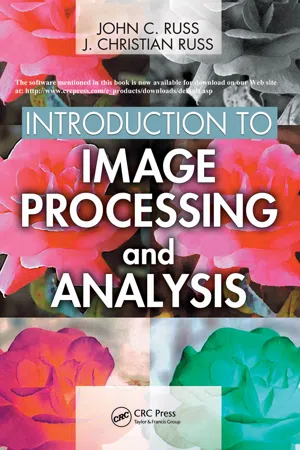Convolution Theorem
The Convolution Theorem states that the convolution of two functions in the time domain is equivalent to the multiplication of their Fourier transforms in the frequency domain. This theorem is widely used in signal processing, image processing, and communication systems to simplify mathematical operations and computations. It provides a powerful tool for analyzing and manipulating signals and systems in various engineering applications.
5 Key excerpts on "Convolution Theorem"
- eBook - ePub
Deconvolution of Images and Spectra
Second Edition
- Peter A. Jansson(Author)
- 2014(Publication Date)
- Dover Publications(Publisher)
...It is essential to the thought process required for both the qualitative understanding of concepts and precise mathematical analysis. Under certain circumstances, it can substantially reduce computation. Easily proved from the definition of the Fourier transform, this theorem states that convolving two functions is equivalent to finding the product of their Fourier transforms. Specifically, if a(x), b(x) and g(x) have transforms A (ω), B (ω) and G (ω) then The theorem works equally well whether we are using plus or minus transforms, so we may write the pair of relationships Superposition may be invoked to determine the behavior of the theorem when the functions are subjected to changes in the sign of real or imaginary, odd or even, components. We have seen in Section III.B that when two functions are convolved, the variance of the convolution product is the sum of the variances of the individual functions. That is, if We see that when two gaussians of equal breadth are convolved, the result is a gaussian √2 times broader. We know that the variance of a gaussian is the reciprocal of the variance of its transform. We apply the Convolution Theorem to obtain The transform of our convolved equal-breadth gaussians is narrower than either individual transformed gaussian. In the present case 1/V2 is the appropriate scaling. The Convolution Theorem plays a valuable role in both exact and approximate descriptions of functions useful for analyzing resolution distortion and in helping us understand the effects of these functions in Fourier space. Functions of interest and their transforms can be constructed from our directory in Fig. 2 by forming their sums, products, and convolutions. This technique adds immeasurably to our intuitive grasp of resolution limitations imposed by instrumentation. 11. Fast Fourier Transform Normally, discrete convolution involves shifting, adding, and multiplying—a laborious and time-consuming process, even in a large digital computer...
- eBook - ePub
- Elizabeth Allen, Sophie Triantaphillidou(Authors)
- 2012(Publication Date)
- Routledge(Publisher)
...In other words, the individual MTFs for the components of an imaging chain combine by simple multiplication to yield the system MTF. This result follows directly from a consideration of the ‘ image of an image ’. CONVOLUTION REVISITED A geometric interpretation of convolution Convolution is such an important process in linear systems theory that it is useful to be familiar with the following geometrical interpretation. The convolution of two functions f (x) and g (x) yields a third function h (x), where: where ξ is the ‘dummy’ variable of the integration. It can be considered an averaging process between the two functions f and g. Given the two functions f and g shown in Figure 7.21, the convolution process involves flipping g left to right as shown to form g (−ξ) and then sliding g (−ξ) across f (ξ). At each position, x, the two functions are multiplied together. The area of the result is the value of the convolution at this position x. As we have seen, the two-dimensional version of this process is the basis of imaging in a linear, stationary imaging system. The Convolution Theorem The Fourier transform of a convolution of two functions is the product of the Fourier transforms of those two functions, i.e. if F (u) is the Fourier transform of f (x), G (u) is the Fourier transform of g (x), and H (u) is the Fourier transform of h (x), a function obtained by the convolution of f (x) with g (x), then: The convolution of two functions has a Fourier transform given by the product of the separate transforms of the two functions. This is a very important result and is the basis of all system analyses using frequency–response curves. Figure 7.21 Geometrical interpretation of convolution. DISCRETE TRANSFORMS AND SAMPLING In the previous sections it has been seen how important Fourier theory is in understanding the formation and properties of images formed in imaging systems...
- eBook - ePub
- John C. Russ, J. Christian Russ(Authors)
- 2017(Publication Date)
- CRC Press(Publisher)
...The procedure of applying a filter to an image is called convolution, whether it is performed in the spatial or the Fourier domains. Equation 3.12 summarizes the convolution relationship. Unlike the application of a mask in Equation 3.10, in which H is a scalar (real) value, for convolution the values of both F and H are complex and, hence, the multiplication is complex. Convolution of an image f (x,y) with a filter h (x,y), indicated by the * symbol can be performed by multiplying the complex Fourier transforms of each, F (u,v) and H (u,v),. respectively. f (x, y) * h (x, y) = 1 N 2 ∑ n = 0 N − 1 ∑ n = 0 N − 1 f (m, n) h (x − m, y − n) f (x, y) * h (x, y) ⇔ F (u, v) H (u, v) (3.12) The advantage of performing convolution in the Fourier domain, as noted before, is that. only a single multiplication is needed for each point in the transform, instead of the dozens or hundreds of multiplications per pixel that would be required to perform the equivalent operation in the spatial domain. The disadvantage is the overhead of the forward and inverse Fourier transform calculations. Code Fragment 3.8 outlines the procedure. Except for very small images and filters, the advantages outweigh the disadvantages...
- eBook - ePub
Image Analysis, Classification and Change Detection in Remote Sensing
With Algorithms for Python, Fourth Edition
- Morton John Canty(Author)
- 2019(Publication Date)
- CRC Press(Publisher)
...For a two-dimensional kernel h (k, l) which has been appropriately padded, the convolution with a c × r pixel array g (i, j) is given by FIGURE 4.2 Illustrating radar ranging. The upper three signals represent reflections of a frequency modulated radar pulse (chirp) from three ground points lying close to one another. Their separation in time is proportional to the distances separating the ground features along the direction of pulse emission, that is, transverse to the flight direction. The fourth signal is the superposition actually received. By convolving it with the emitted signal waveform, the arrival times are resolved (bottom signal). f (i, j) = ∑ k = 0 c − 1 ∑ ℓ = 0 r − 1 h (k, ℓ) g (i − k, j − ℓ). (4.4) The Convolution Theorem now reads h ∗ g ⇔ c ⋅ r ⋅ h ^ ⋅ g ^, (4.5) so that convolution can be carried out in the frequency domain using the Fourier and inverse Fourier transforms in two dimensions, Equations (3.9) and (3.8). 4.2 Linear filters Linear filtering of images in the spatial domain generally involves moving a template across the image array, forming some specified linear combination of the pixel. intensities within the template and associating the result with the coordinates of the pixel at the template’s center. Specifically, for a rectangular template h of dimension (2 m +1) × (2 n +1), f (i, j) ∑ k = − m m ∑ ℓ = − n n h (k, ℓ) g (i + k, j + ℓ), (4.6) where g represents the original image array and f the filtered result. The similarity of Equation (4.6) to convolution, Equation (4.4), is readily apparent and spatial filtering can be carried out in the frequency domain if desired. Whether or not the Convolution Theorem should be used to evaluate Equation (4.6) depends again on the size of the arrays involved. Richards (2012) gives a detailed discussion and calculates a cost factor F = m 2 2 log 2 c + 1 ⋅ e for an m × m template on a c × c image...
- eBook - ePub
- Nassir H. Sabah(Author)
- 2017(Publication Date)
- CRC Press(Publisher)
...The usefulness of FT techniques has been greatly enhanced by digital computation, based on a rapid and efficient algorithm known as the fast Fourier transform (FFT) that computes the discrete Fourier transform (DFT). This transform is an approximation to the FT that produces a finite set of discrete-frequency spectrum values from a finite set of discrete-time values. The DFT and FFT are discussed in Section ST16.4 and Section ST16.5. Learning Objectives To be familiar with: FTs of functions commonly encountered in signal analysis To understand: The basic properties of the FT, particularly duality and the convolution properties The application of the FT to analyzing electric circuits The interpretation and applications of Parseval’s theorem Some basic properties of signals, namely, causality, bandwidth, and duration-bandwidth product Some basic properties of systems, namely, impulse response, causality, linearity, time invariance, memory, invertibility, and stability 16.1 Derivation of the Fourier Transform The FT can be derived from the exponential form of the Fourier series expansion (FSE) of a periodic waveform as the period becomes infinitely large. Consider as an example the FSE of the rectangular pulse train analyzed in Example 9.2.3 (Chapter 9). As the period of the function becomes infinitely large, the waveform reduces to a single pulse of amplitude A and duration τ, extending from to. t =−τ/2 to t =+τ/2. C n to of the waveform was found to be given by: C n = A τ T sin c (n ω 0 τ / 2) (Equation 9.2.18, Chapter 9). As T will be made very large, and w 0 correspondingly very small, let us consider C N T instead of C N. Thus: C n T = ∫ − T / 2 T / 2 f (t) e − j n ω 0 t d t = A τ sin c (n ω 0 τ / 2), = 0, ± 1, ± 2,... (16.1.1) Figure 16.1.1a shows the plot of C n T vs. n ω 0 for the case of T = 5 τ illustrated in Example 9.2.3 (Chapter 9)...




